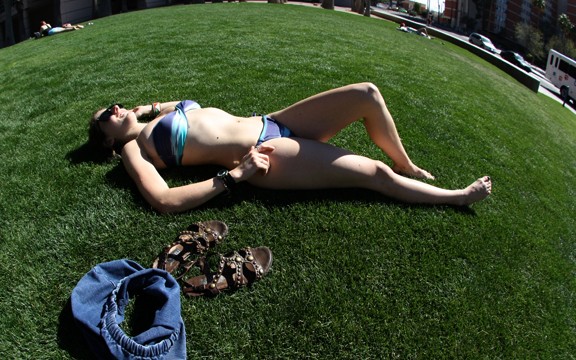People have worshipped the sun for thousands of years. Neolithic cultures, Aztec civilizations and Panhellenic organizations have all paid homage to the solar deity.
Golden, sun-kissed skin is undoubtedly desirable, so when thinking about spring break, third degree sunburns are probably pretty far down the list. In fact, they’re probably not on anyone’s spring break list at all, but proper skin care in the sun can make the difference between a healthy tan and scorching red skin.
Despite all the benefits of sunlight, the sun does emit harmful UVA and UVB rays that can damage our skin with prolonged exposure.
While both can contribute to the development of skin cancer, UVB rays are the ones that give you that painful sunburn. UVA rays, on the other hand, penetrate deeper into the skin, contributing to premature aging over time. These rays get to our skin most easily, and at all times of the day.
It’s healthy to spend some time in the sunshine — that’s how we get our vitamin D, after all — but remember to be mindful of your skin in the process.
Due to our cultural belief that being tan makes you looks healthy, America tops the charts for number of per-capita cases of skin cancer, said Dr. Henry W. Lim, chairman of the Department of Dermatology for the Henry Ford Health System. claims this is.
To begin your healthy skin regimen, become familiar with your skin type and tone. Do you have extremely light skin that burns easily and never tans, or do you have a darker complexion that tans easily and hardly burns at all? Maybe you’re somewhere in between.
Those with lighter, sun-sensitive skin need to be particularly mindful of their time in the sun and should wear hats or sit in the shade fairly often. However, people with darker skin need to stay alert as well, as it’s all too easy for signs of skin cancer to go undiagnosed.
No matter what your skin type, you should apply an ounce (about a shot glass full) of SPF 30 sunscreen to all exposed areas when you’re spending time outside. This SPF level is designed for all-purpose use and won’t suffocate your skin, so it can still breath and sweat. Reapply sunscreen every few hours, especially if you’re swimming or doing high-energy activities. Unfortunately, many sunscreens don’t protect against UVA rays, so look for one with broad-spectrum protection.
If you do get a sunburn, either by ignoring precautions or passing out on the beach for an extended period of time, don’t worry.
Begin by taking a bath with somebaking soda or oatmeal. The bath should be lukewarm, as anything hotter than that will increase the irritation. Be forewarned that soaking in the suds for too long could cause the burn to dry out.
Surprisingly enough, potatoes can also help soothe painful areas. Blend a potato until it forms a paste, then apply to the skin and wait. The potatoes will help relieve redness and calm irritation.
Be extremely generous when it comes moisturizing, as this will help hydrate the skin and stop it from peeling. Use anything from unscented lotion to aloe vera. You can even wash clothes with cold milk to help sooth your skin.
The key is to keep the skin hydrated and far from any other possible irritants.
Lastly, drink plenty of water, since a sunburn is accompanied by dehydration of the skin.
Take care of yourself out there. Spring break is meant for piña coladas and daiquiris on the beach, not a week spent tending to aching burns.









